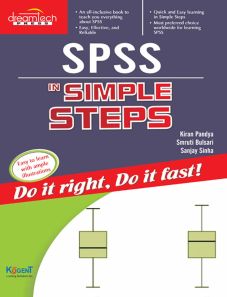SPSS in Simple Steps
ISBN: 9789350042519
200 pages
eBook also available for institutional users
For more information write to us at: acadmktg@wiley.com

Description
SPSS in Simple Steps is very useful for all students, researchers and faculty members who need to analyze quantitative data in their research work. The objective of the book is to help the students and researchers to undertake statistical analysis using PASW / SPSS software package. It is designed to be read in front of the computer screen. The book commences with an introduction to the PASW / SPSS software and provides a step-by-step approach for explaining procedures and executing PASW / SPSS commands. It provides a clear understanding of commands, procedures and functions required for carrying out statistical analysis. The book covers basic and essential features of PASW/SPSS.
Overview of PASW Statistics
Introduction to PASW
1.2 Menus
1.3 Tool Bar
1.4 Dialogue Box
1.5 Designate Window
1.6 Basic Steps for performing any Statistical Procedure
Data Management
2.1 Creating a Data File
2.2 Defining Variables
2.3 Entering the Data
2.4 Saving Data
2.5 Opening an existing Data File
2.6 Inserting Variables
2.7 Inserting Cases
2.8 Identifying Duplicate Cases
2.9 Identifying Unusual Cases
2.10 Sorting Cases
2.11 Merging a File
2.11.1 Add Cases
2.11.2 For Adding Variables
2.12 Data Aggregation
2.13 Splitting File
2.14 Selecting Cases
2.15 Listing Cases
Data Transformation
3.1 Computing a New Variable
3.2 Recoding Variables
3.3 Automatic Recode
3.4 Visual Binning
3.5. Rank Cases
Describing Data Numerically
4.1 Types of Measurement Scales
4.2 Summary Measures
4.2.1 Frequencies
4.2.2 Descriptive Statistics
4.2.3 Explore
4.2.4 Crosstabs
Describing Data Graphically
5.1 Line Chart
5.2 Pie Chart
5.3 Bar Chart
5.4 Histogram and the Standard Normal Curve
5.5 Box Plot
5.6 Scatter Diagram
5.7 P?P Plot
5.8 Q?Q Plot
5.9 Chart Builder
5.10 Formatting Charts
One Sample t?Test
6.1 Hypothesis Testing
6.1.1 Steps in Hypothesis Testing
6.1.2 Assumptions of Hypothesis Testing
6.2 Testing for Population Mean
6.3 Statistical and Practical Significance
Independent Sample t?Test
7.1 Assumptions of Independent Sample t?Test
7.2 Procedure for Testing for Differences in Means between Groups
7.3 Interpretation of Null Results
7.4 Effect Size
Paired Samples t?Test
8.1 Assumptions of Paired Samples t?Test
8.2 Procedure for Paired Sample t?test
One?Way ANOVA
9.1 Assumptions of One?Way ANOVA
9.2 Procedure for Testing for Differences in Means between Groups
9.3 Post Hoc Analysis
9.4 Procedure for undertaking Post Hoc Analysis
9.5 Measure of Association
One?Way Repeated Measures ANOVA
10.1 Assumptions of One?Way Repeated Measures ANOVA
10.2 Procedure for Undertaking One?Way Repeated Measures ANOVA
Two?Way ANOVA
11.1 Assumptions of two?way ANOVA
11.2 Procedure for Undertaking Two?Way ANOVA
Correlation
12.1 Assumptions of Correlations
12.2 Procedure for Undertaking Correlations
12.2.1 Bivariate Correlations
12.2.2 Rank Correlations
12.2.2 Partial Correlations
Multiple Regression
13.1 Assumptions of Linear Regression
13.2 Procedure for undertaking Linear Regression
Nonparametric Statistics
14.1 Runs Test
14.2 Chi?Square Test
14.3 Mann?Whitney U Test
14.4 Wilcoxon Signed Rank Test
14.5 Kruskal?Wallis Test
Logistic Regression
Reliability Analysis
Factor Analysis
17.1 Principal Components Method
17.2 Necessary Conditions for Undertaking Principal Component Analysis
17.3 Procedure for Undertaking Principal Component Analysis
Summary
Appendix-A Dataset for students.sav

